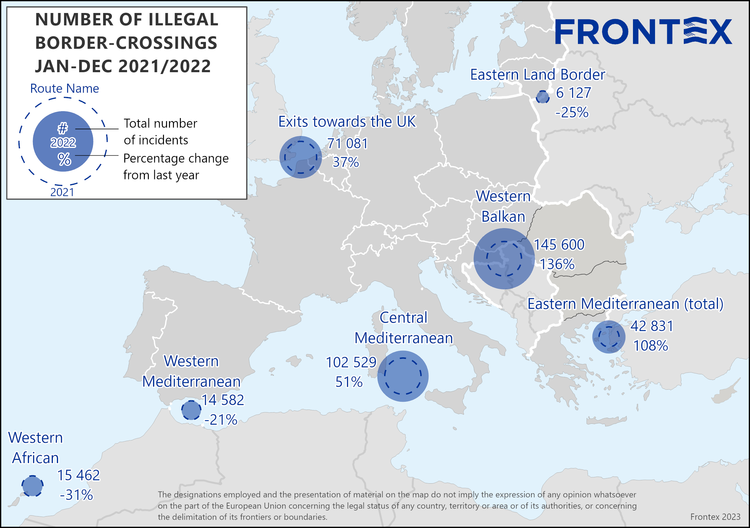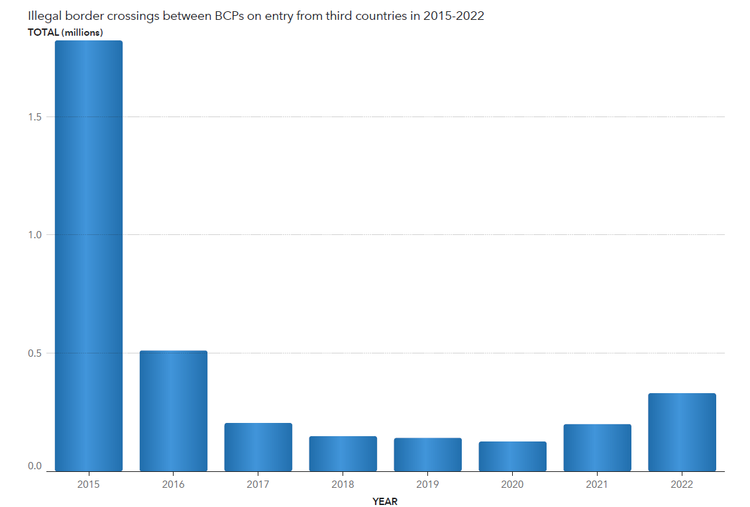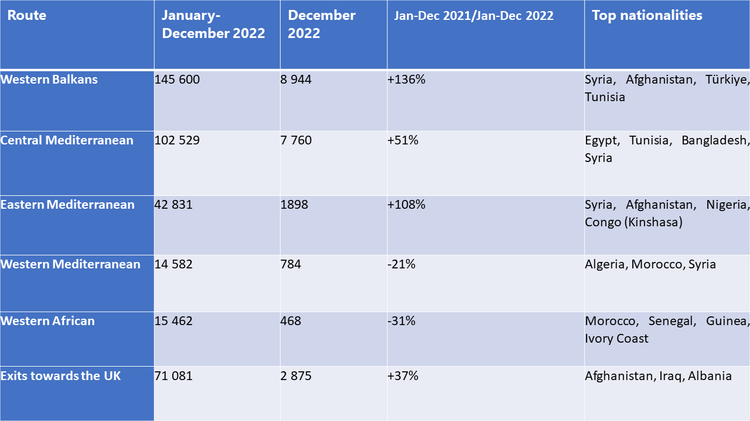In 2022, around 330 000 irregular border crossings were detected at EU’s external border, according to preliminary calculations*. This is the highest number since 2016 and an increase of 64% from the previous year.
After the pandemic-induced low in 2020, this was the second year in a row with a steep rise in the number of irregular entries. The Western Balkan route accounted for nearly half of the total. Syrians, Afghans and Tunisians together accounted for 47% of the detections in 2022. The number of Syrians roughly doubled to 94 000.
Women accounted for fewer than one in ten of the detections, while the share of reported minors fell slightly to around 9 percent of all detections.
Separately, almost 13 million Ukrainian refugees were counted on entry at the EU’s external land borders from Ukraine and Moldova between 24 February 2022 until the end of the year, which are not included in these figures. In the same period, 10 million Ukrainian nationals were reported on exit at the same border sections.
Last year, EU and Schengen associated countries faced unprecedented challenges at their external borders. These have ranged from the state-organised migration perpetrated by Belarus from 2021 onward to Russia’s invasion of Ukraine in February 2022. The later caused record numbers of refugees arriving in the European Union. These events, along with the steadily increasing number of irregular crossings, demonstrate the need for strong and effective European Border and Coast Guard, with Frontex as strong supporter of Member States.

The Western Balkan route
In 2022, there were 145 600 irregular border crossings reported on the Western Balkans route, 136% more than in 2021. This is the highest number of crossings reported on this route since 2015 and about half of all reported irregular entries in 2022.
Citizens of Syria, Afghanistan and Türkiye accounted for the largest number of detections. Nationalities that previously had been little on this route were also reported, such as Tunisians, Indians and Burundis.
The Central Mediterranean route
The number of detections in the Central Mediterranean rose by more than half to well over 100 000 detections. Egyptians, Tunisians and Bangladeshis were the top three nationalities in a year that saw the most arrivals in this region from Libya since 2017 and the most from Tunisia in recent history.
The Eastern Mediterranean route
In 2022, there were about 42 800 irregular border crossings detected on the Eastern Mediterranean route. Syrians, Afghans and Nigerians were the top reported nationalities. Figures roughly doubled compared with 2022 yet remained below half of the figures in 2019.

Other routes
The Western Mediterranean route saw a decrease in migratory pressure in 2022 with around a fifth fewer detections than in the previous year. While 80 % of the irregular migrants come from Northwest African countries, selected Sub-Saharan African nationalities recorded major increases, as did Syrians.
On the Western African route, there were 15 460 arrivals in 2022, 31% less than in 2021. More than two-thirds of the detected migrants coming from Morocco and various sub-Saharan countries.
In 2022, Frontex had about 20 operations at and beyond EU’s external borders and an average of 2000 standing corps officers deployed.
In the English Channel, over 71 000 irregular border crossings were detected on exit, including both attempts and successful crossings. Over 50 different nationalities were recorded in the Channel, most of them from the Middle East, Albania and the Horn of Africa.

*The figure includes other less active migratory routes not mentioned in this press release. The final figures may be higher due to delayed reporting.
Note: The preliminary data presented in this statement refer to the number of detections of irregular border-crossing at the external borders of the European Union. The same person may attempt to cross the border several times in different locations at the external border.
Source: Frontex News

